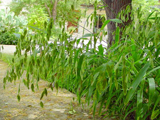Native Plants

Q. Who is Mr. Smarty Plants?
A: There are those who suspect Wildflower Center volunteers are the culpable and capable culprits. Yet, others think staff members play some, albeit small, role. You can torture us with your plant questions, but we will never reveal the Green Guru's secret identity.
Did you know you can access the Native Plant Information Network with your web-enabled smartphone?
Ask Mr. Smarty Plants is a free service provided by the staff and volunteers at the Lady Bird Johnson Wildflower Center.

rate this answer
Saturday - March 23, 2013
From: Trinity, TX
Region: Southwest
Topic: Non-Natives, Deer Resistant, Herbs/Forbs, Shrubs
Title: Deer resistant plants for Trinity, TX
Answered by: Barbara Medford
QUESTION:
I need a list of deer resistant flowers, herbs and plants that would could be planted in Trinity, Texas.ANSWER:
When we say "herb," we mean herbaceous blooming plants, native to North America. If, when you say "herbs," you mean plants like rosemary, lavender and such, those are all native to the Meditteranean area and won't be in our Native Plant Database. Some of those non-native plants do quite well in East Texas, including Trinity County, but we won't be recommending them.
The second problem with your request is the "deer-resistant" stipulation. We have a list of deer-resistant plants; please read this disclaimer paragraph from the top of the list:
"Deer Resistant Species
Few plants are completely deer resistant. Several factors influence deer browsing including the density of the deer population, environmental conditions such as drought, and plant palatability. Deer tend to avoid plants with aromatic foliage, tough leathery and/or hairy or prickly leaves or plants with milky latex or sap. Try using some of the plants listed here to minimize deer damage to your landscape."
Further complicating this problem is the fact that there are only 346 plants on that list, and that constitutes the deer-resistant plants for North America, including Canada but not including Mexico. By the time we sort that list down to not only Texas, but East Texas, there will be very few choices. First, we will go to our list of Deer Resistant Species and then, using the Sidebar on the right-hand side of that page, we will select on Texas for the state, and nothing else, so that we will get a list of all plants in Texas having exhibited some deer resistance. Caution: You will need to read the whole webpage on each plant; some of the indicators will be "Highly Resistant" under deer resistance, some will only be "Moderately Resistant." Our examples are all Highly Resistant.
For each plant on our list, we will go down the webpage to the bottom and click on the link on that plant to the USDA Plant Profiles. This will get a map of all of North America, with the states where that plant grows in green. Since we have stipulated Texas for the state, it will always be green for the plants we have listed. Click on the state of Texas, and you will get a map with the counties where the plants grow in green. This is a good one to check on each plant, because there are so many different ecosystems in Texas, and some of the other areas in Texas might be distinctly hostile to the plants for East Texas, in terms of heat, soil and amount of rain.
Before we present you with our list, we are going to add some plants you did not ask for but that deer do not generally care to eat. There are a number of native grasses and grass-like plants that are very attractive, hold their places all year, some needing sun and some part shade. These are not lawn grasses, and you will need to check each webpage to see what they require.
So, here is a list of the plants on the Deer Resistant list, native to Texas. We will also check that each one we list is native in or near Trinity County, Texas.
Adiantum capillus-veneris (Southern maidenhair fern)
Amorpha fruticosa (Indigo bush)
Asclepias tuberosa (Butterflyweed)
Coreopsis tinctoria (Plains coreopsis)
Andropogon gerardii (Big bluestem)
From the Image Gallery
More Non-Natives Questions
Planting non-native peach seed from Archdale NC
September 13, 2010 - Planting and watering peach seeds. Can you give advice for my 12 year old who has recently planted some peach seeds in our yard in Archdale NC? Is the fall okay for planting? Watering instructions? I...
view the full question and answer
Trimming spineless yucca in Chicago
April 05, 2011 - I have a spineless yucca (indoors) which is 11 feet tall and thirty-five years old. When the yucca recently started to scrape the ceiling, I moved it away (roughly 20 feet) from the windows to an area...
view the full question and answer
Will native plants become invasive from Grapevine TX
February 23, 2013 - Main Question - I want to convert my front and back yards into a native plant sanctuary but worry about if these plants growing out of control/invasive and if neighbors will complain about these "wee...
view the full question and answer
Problems with non-native King Sago Palm
April 13, 2009 - My king sago palm has not branched out in over a year. I think it needs to be fertilized. What can I do?
view the full question and answer
Problems with non-native althea in Georgetown, TX
June 20, 2009 - My white althea's leaves have a white edge, last year the bloom did not open. Is it sick?
view the full question and answer
| Support the Wildflower Center by Donating Online or Becoming a Member today. |

